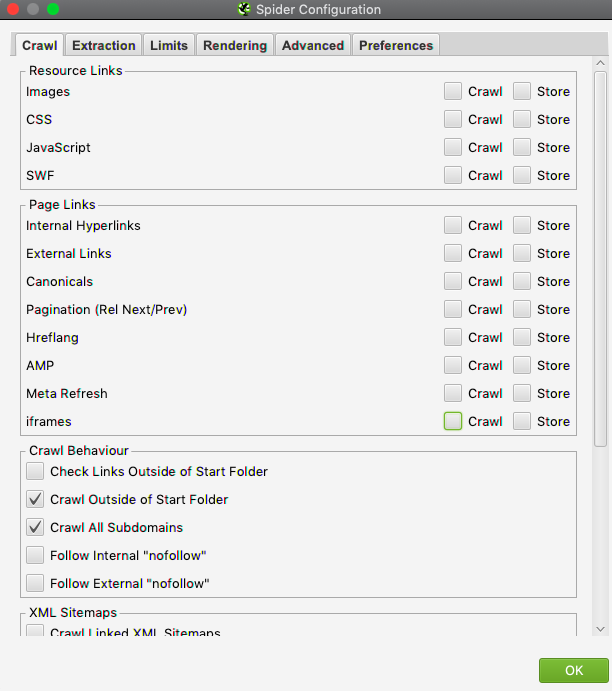
How to find redirect chains using Screaming Frog
by Rajiv SinghaIf a site has existed for a couple of years, there’s a good chance that you will find redirect chains on it.
What is a redirect chain?
In simple terms, a redirect chain is formed when URL A redirects to URL B and URL B may further redirect to URL C. This could continue for N number of times. The number of intermediate redirects is commonly called redirect hops.
The processes described below assume you have some basic familiarity with Screaming Frog and how to set up a crawl on it.
How to find redirect chains using Screaming Frog in Spider or List Mode
- Go to Configuration > Spider > Advanced. Check Always Follow Redirects to true. Set up the rest of the settings as you feel necessary. For details check out Screaming Frog’s official how to guide.
- Set Max Redirects to Follow number to what you prefer. 5 is default and fine. Run the crawl after all settings are configured.
- Go to Configuration > Spider > Crawl > Crawl Behavior and set Check Links Outside of Start Folder to true OR set Crawl Outside of Start Folder to true.
Checking either of these 2 settings works but the setting “Crawl outside the start folder” is the one.
Run the crawl after all settings are configured. - Go to Reports > Redirects > Redirect Chains and export your file in the desired format.

Why this setting is important when finding redirect chains with Screaming Frog
Imagine the two cases of redirect chains below:
- http://seotesting.CueForGood.com/blog/how-to-be-awesome → http://seotesting.CueForGood.com/blog/how-to-become-awesome → http://seotesting.CueForGood.com/blog/you-are-awesome →
http://seotesting.CueForGood.com/index.html - http://seotesting.CueForGood.com/blog/how-to-be-amazing → http://seotesting.CueForGood.com/blog/how-to-become-amazing → http://seotesting.CueForGood.com/resources/you-are-amazing →
http://seotesting.CueForGood.com/index.html
In both cases, the redirect chain goes through 3 hops to reach the final destination. However, if you run it in screaming frog and do not set Crawl Outside of Start Folder to true, then Screaming Frog will read the first case as 3 redirects and the second one as 2 redirects.
Case #1 Result – Without enabling “Check Outside of Start Folder”
Case #2 Result – After enabling “Check Outside of Start Folder”
Reason – The folder /resources/ is outside the start folder i.e. /blog/. By setting the Crawl Outside of Start Folder true you are telling Screaming frog to follow the redirects no matter what.
It is incredible how a simple setting can create an almost undetected issue in your analysis.
Screaming frog is an incredible tool. However, without a good understanding of all the features, the tool has to offer, your crawl reports might be incomplete or inaccurate.
- About the Author
- Latest Posts
I am part of the CueForGood’s Organic Search(SEO) team. I love playing football and reading about Technical SEO.
-
Email Marketing Without Fatiguing Conscious Consumers
by Charanjeev Singh
How to build trust, reduce inbox overload, and engage with intention Email marketing is a powerful tool. It lets …
Continue reading “Email Marketing Without Fatiguing Conscious Consumers”
-
How to Market Vegan Products Without Preaching (or Losing Sales)
by Tapam Jaswal
Marketing vegan products isn’t just about talking to people who already follow a vegan lifestyle. It’s also about connecting with …
Continue reading “How to Market Vegan Products Without Preaching (or Losing Sales)”
-
Vegan SEO: Optimizing Organic Visibility for Vegan Brands
by Tapam Jaswal
More people than ever are interested in vegan products and services. If you run a vegan brand, ensuring customers can …
Continue reading “Vegan SEO: Optimizing Organic Visibility for Vegan Brands”
-
Google AI Mode Explained: How It’s Reshaping Search and Content with Real Examples & Tips
by Tapam Jaswal
If you’re in SEO or content and have been watching Google’s changes, you already know: AI Mode isn’t a minor …
-
Jiva’s Organic Traffic Growth: 354% Surge in 6 Months | CueForGood
by Nida DanishSummary: Jiva’s efforts to empower smallholder farmers weren’t gaining the digital traction they deserved. With a strategic overhaul led by …
Continue reading “Jiva’s Organic Traffic Growth: 354% Surge in 6 Months | CueForGood”
-
What We Learned When We Switched From Disposable Tissues to Reusable Napkins
by Nida DanishAt CueForGood (CFG), we’ve embraced a refreshing change: reusable cloth napkins. While the switch may seem minor, it’s rooted in …
Continue reading “What We Learned When We Switched From Disposable Tissues to Reusable Napkins”






7 Replies to “How to find redirect chains using Screaming Frog”